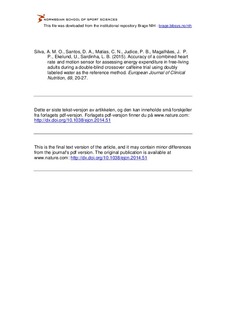| dc.contributor.author | Silva, Analiza M. | |
| dc.contributor.author | Santos, Diana A. | |
| dc.contributor.author | Matias, Catarina Nunes | |
| dc.contributor.author | Judice, Pedro B. | |
| dc.contributor.author | Magalhães, João Paulo P. | |
| dc.contributor.author | Ekelund, Ulf | |
| dc.contributor.author | Sardinha, Luis B. | |
| dc.date.accessioned | 2016-04-06T08:42:19Z | |
| dc.date.available | 2016-04-06T08:42:19Z | |
| dc.date.issued | 2015-01 | |
| dc.identifier.citation | European Journal of Clinical Nutrition 2015, 69, 20-27. | nb_NO |
| dc.identifier.uri | http://hdl.handle.net/11250/2384187 | |
| dc.description | Dette er siste tekst-versjon av artikkelen, og den kan inneholde små forskjeller fra forlagets pdf-versjon. Forlagets pdf-versjon finner du på www.nature.com: http://dx.doi.org/10.1038/ejcn.2014.51 / This is the final text version of the article, and it may contain minor differences from the journal's pdf version. The original publication is available at www.nature.com: http://dx.doi.org/10.1038/ejcn.2014.51 | nb_NO |
| dc.description.abstract | Background/Objectives:
A combined heart rate (HR) and motion sensor (Actiheart) has been proposed as an accurate method for assessing total energy expenditure (TEE) and physical activity energy expenditure (PAEE). However, the extent to which factors such as caffeine may affect the accuracy by which the estimated HR-related PAEE contribution will affect TEE and PAEE estimates is unknown. Therefore, we examined the validity of Actiheart in estimating TEE and PAEE in free-living adults under a caffeine trial compared with doubly labeled water (DLW) as reference criterion.
Subjects/Methods:
Using a double-blind crossover trial (Clinicaltrials.gov ID: #NCT01477294) with two conditions (4-day each with a 3-day-washout period), randomly ordered as caffeine (5 mg/kg per day) and placebo (malt-dextrine) intake, TEE was measured by DLW in 17 physically active men (20–38 years) who were non-caffeine users. In each condition, resting energy expenditure (REE) was assessed by indirect calorimetry and PAEE was calculated as (TEE−(REE+0.1 TEE)). Simultaneously, PAEE and TEE were estimated by Actiheart using an individual calibration (ACC+HRstep).
Results:
Under caffeine, ACC+HRstep explained 76 and 64% of TEE and PAEE from DLW, respectively; corresponding results for the placebo condition were 82 and 66%. No mean bias was found between ACC+HRstep and DLW for TEE (caffeine:-468 kJ per day; placebo:-407 kJ per day), although PAEE was slightly underestimated (caffeine:-856 kJ per day; placebo:-1147 kJ per day). Similar limits of agreement were observed in both conditions ranging from −2066 to 3002 and from −3488 to 1776 kJ per day for TEE and PAEE, respectively.
Conclusions:
Regardless of caffeine intake, the combined HR and motion sensor is valid for estimating free-living energy expenditure in a group of healthy men but is less accurate for an individual assessment. | nb_NO |
| dc.language.iso | eng | nb_NO |
| dc.publisher | Nature publishing group | nb_NO |
| dc.subject | physical activity | nb_NO |
| dc.subject | indirect calorimetry | nb_NO |
| dc.subject | heart rate monitoring | nb_NO |
| dc.subject | accelerometry | nb_NO |
| dc.subject | methods | nb_NO |
| dc.title | Accuracy of a combined heart rate and motion sensor for assessing energy expenditure in free-living adults during a double-blind crossover caffeine trial using doubly labeled water as the reference method. | nb_NO |
| dc.type | Journal article | nb_NO |
| dc.type | Peer reviewed | nb_NO |
| dc.subject.nsi | VDP::Medical disciplines: 700 | nb_NO |
| dc.subject.nsi | VDP::Medical disciplines: 700::Health sciences: 800 | nb_NO |
| dc.subject.nsi | VDP::Medical disciplines: 700::Health sciences: 800::Nutrition: 811 | nb_NO |
| dc.source.journal | European Journal of Clinical Nutrition | nb_NO |
| dc.identifier.doi | 10.1038/ejcn.2014.51 | |
| dc.description.localcode | Seksjon for idrettsmedisinske fag / Department of Sports Medicine | nb_NO |
